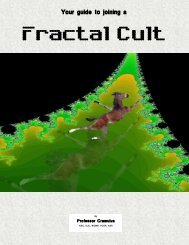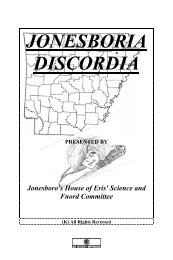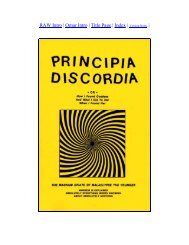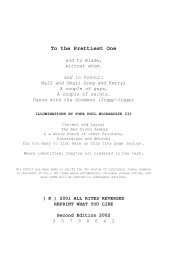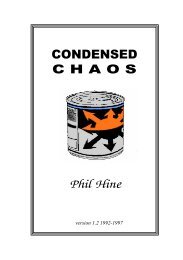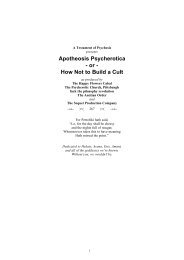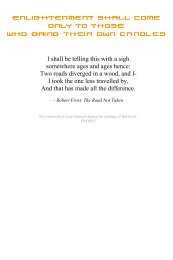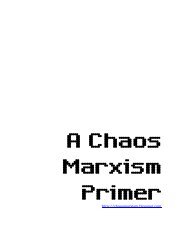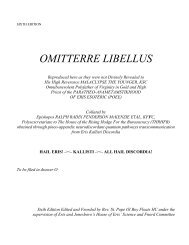Coincidance - Principia Discordia
Coincidance - Principia Discordia
Coincidance - Principia Discordia
Create successful ePaper yourself
Turn your PDF publications into a flip-book with our unique Google optimized e-Paper software.
206 COINCIDANCE<br />
Dali, who had a Jewish wife and fled France as soon as Hitler invaded, was<br />
speaking in a totally dispassionate and non-aristotelian fashion when he<br />
"defended" the monster. Hitler did indeed have four balls and six foreskins,<br />
in the same sense that Lenin had one giant buttock, as in Daii's famous<br />
painting of him. Perhaps Daii's attitude toward Hitler would have been<br />
clearer if he had painted it, as he painted his attitude toward Lenin, instead of<br />
trying to verbalize the ineffable. After all, if one Russian General gets shot<br />
by a man with the same name as America's leading conservative and<br />
another gets shot by a man with the same name as the chap who proved<br />
Irish was an Indo-European language, it is only logical that a third Russian<br />
General should heist the Maltese Falcon, right?<br />
But seriously, folks—as Bob Hope used to say—the method used by Tzara<br />
in breaking the back of Aristotelianism was the same method used by Claud<br />
Shannon in discovering the mathematical definition of information. Look it<br />
up in Shannon's The Mathematical Theory of Communication. Dr. Shannon cut up<br />
prose into single words, threw them in a hat, picked them out one at a time—<br />
just like Tristan without Isolde creating a Dada poem—and from this<br />
Shannon produced not poetry but the ideas that allowed him to define<br />
information as the opposite of predictability. The basic equation is elegant,<br />
and is given also in my book Right Where You Are Silting Now and it was this<br />
mathematical analysis that made possible the word processor on which I am<br />
writing this.<br />
That this word processor is called a Mackintosh—like the man who haunts<br />
Bloom all through 16 June 1904—is "only" a coincidence, of course. Of course.<br />
Painters explored collage extensively in the 40 years after Tzara's breakthrough,<br />
and every motion picture director conducted extensive research in<br />
montage, but prose and poetry, with few exceptions {Joyce, Pound, Williams)<br />
moved backward like a crab and crawled into the Victorian or pre-<br />
Einsteinian murk. The second quantum leap occurred in the late 1950s<br />
when William S. Burroughs began experimenting with the cut-up and<br />
fold-in techniques and created a prose of incredible accidental beauty and<br />
Zen humor.<br />
I have used various cut-up and other stochastic techniques in all my novels<br />
and have noticed one amusing thing about the response to this: hostility is<br />
expressed most widely if I admit that I am using "mechanical" techniques of<br />
the Burroughs and Tzara variety. If I do not publicize this fact, there is much<br />
less hostility. It appears that lazy readers are only terrified of the new if they<br />
are warned in advance that it actually is novel and experimental. Otherwise<br />
they just pass over it as a confusing passage and forget it. I am not interested<br />
in lazy readers, however, but in the attentive and awake.<br />
The techniques used in creating the following experiment were not possible






